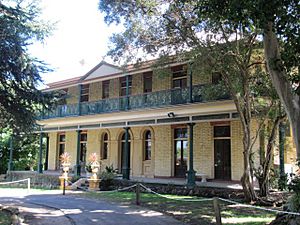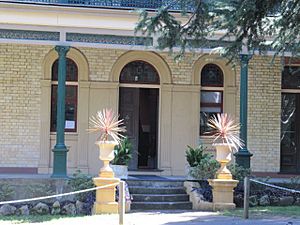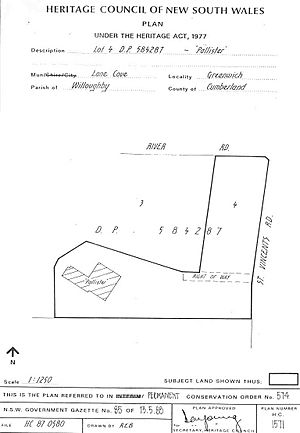Pallister, Greenwich facts for kids
Quick facts for kids Pallister, Greenwich |
|
|---|---|
 |
|
| Location | 95 River Road, Greenwich, Municipality of Lane Cove, New South Wales, Australia |
| Built | 1892 |
| Architectural style(s) | Victorian |
| Owner | Anglican Church Property Trust |
| Official name: Pallister; Standish; Greenwich Hospital | |
| Type | State heritage (built) |
| Designated | 2 April 1999 |
| Reference no. | 574 |
| Type | Mansion |
| Category | Residential buildings (private) |
| Lua error in Module:Location_map at line 420: attempt to index field 'wikibase' (a nil value). | |
Pallister is a special building in Greenwich, New South Wales, Australia. It has a long history and has been many things. It was once a private girls' school, a home for children, and a large country house. Today, it is part of a hospital.
This building is also known as Standish and Greenwich Hospital. It is owned by the Anglican Church Property Trust. Pallister is so important that it was added to the New South Wales State Heritage Register on 2 April 1999. This means it is protected for its historical value.
Contents
History of Pallister
Building a Grand Home
The house was first called Standish. It was built in 1892 for a man named John St Vincent Welch. He was born in England in 1847 and moved to Australia in 1876.
People believe that John St Vincent Welch designed Standish himself. However, some parts of the house, like the special stair hall, suggest an architect might have helped. Many of the building materials came from England. This included the beautiful mahogany wood for the grand staircase. The roof slates and a marble fireplace also came from England.
Life at Standish
Standish was built away from River Road. It faced south-east and had amazing views. You could see across the Lane Cove River and Parramatta River. On clear days, you could even see the distant Blue Mountains.
By 1894, the land in front of the house was cleared. A clay driveway led to a circular loop for carriages. This driveway continued past the house to the stables and garage. There were big timber gates for carriages and smaller ones for people.
John St Vincent Welch also built an observatory by 1900. An amazing telescope was brought from England in 1860. It was used to watch the transit of Venus, a rare event where Venus passes in front of the Sun.
Gardens and Recreation
The gardens on the southern side of the house were lovely. Stone walls and paths wound through the bushland. Steps led down to a lower garden, a tennis court, and a swimming pool. These steps were called Tarpeian Way.
The grass tennis court and swimming pool were built on land bought in 1896. The pool was made before 1910. It was carved into the natural sandstone and lined with large sandstone blocks. There were also two more clay tennis courts near River Road.
Changing Uses Over Time
In 1937, the Sydney Church of England Girls Grammar School (SCEGGS) bought the property. They wanted to expand their school. A new wing was added in 1938 for classrooms.
In 1946, the Church of England Deaconess' Institute took over. They used the property as a home for girls. At this time, the house was renamed Pallister.
By the 1970s, Greenwich Hospital started using much of the land. Pallister was left with only three acres. The tennis and netball courts became lawns. In 1981, Pallister stopped being a children's home. This ended its almost 40 years of helping young people.
Since 1981, Pallister has been part of Greenwich Hospital. It has housed different hospital services. Today, it still holds offices for various hospital departments.
What Pallister Looks Like
The Site and Surroundings
Standish was built facing south-east, away from River Road. It offered amazing views over the bushland. From the southern side, you could see the Lane Cove and Parramatta Rivers. The distant Blue Mountains were also visible.
By 1894, the land in front of the house was cleared. A clay driveway with a circular loop for carriages was built. This driveway continued past the house to the stables and garage. The entrance had large timber gates for carriages and a smaller gate for people.
Below the driveway on the eastern side, the land dropped away. It contained natural caves and grottoes. By 1900, an observatory was built in the grounds. It housed a telescope brought from England in 1860.
Stone walls and paths wound through the bushland below the gardens. Steps led down to the lower garden, tennis court, and swimming pool. The pool was carved into the sandstone and lined with large blocks. Two more clay tennis courts were near River Road.
The House Itself
Pallister is a two-storey house built in the Late Victorian style. It has large additions on its western side. These additions were built in 1937-38 when the house became a girls' school.
Both the original house and the newer parts are made of strong brickwork. A two-storey verandah wraps around three sides of the house. It has decorative cast iron columns and panels. The main entrance is in the middle of the eastern side. It is located below a pointed roof section called a gable.
The main roof is made of slate tiles. The newer additions generally have terra cotta tiles. Inside, many of the original features are still there. Only small changes have been made over the years.
Why Pallister is Special
Pallister is important because it shows what a grand home looked like in the late Victorian era. It was built in 1892 for John St Vincent Welch and his family. The house helps us understand how areas like Lane Cove and North Sydney grew.
Standish is a rare example of a large Victorian gentleman's home in Greenwich. It shows the lifestyle and dreams of John St Vincent Welch. It is the best example of a Victorian villa with its original garden setting. This includes the tear-drop shaped driveway for carriages.
The house is connected to John St Vincent Welch and his family. He was a successful businessman. He also helped the community in many ways. He was an alderman for local councils. He helped start music clubs and was a trustee for the Art Gallery of New South Wales.
Pallister was also the childhood home of Kenyon St Vincent Welch. He became the first doctor to work for the famous Flying Doctor Service. Since 1946, the building has been linked to the Anglican Deaconess Institute Sydney. It has been used for many welfare and community activities, especially for teenage girls.
Because of its rich history and importance, Pallister was added to the New South Wales State Heritage Register on 2 April 1999.



